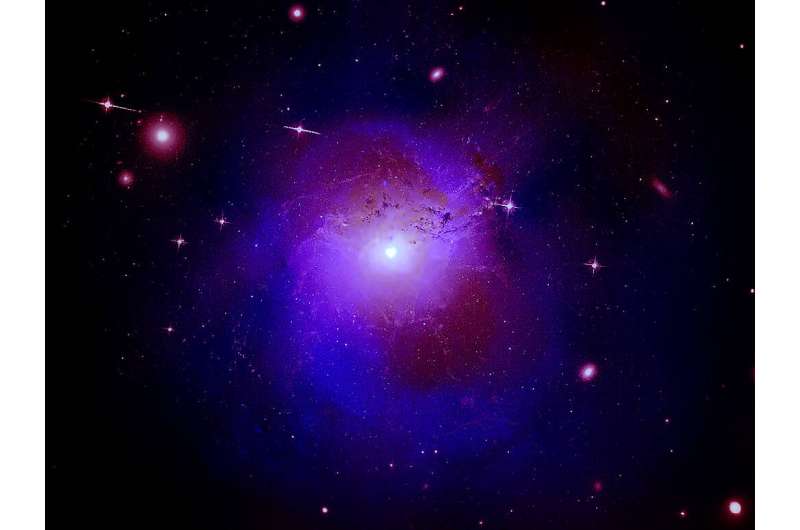This article has been reviewed according to Science X's editorial process and policies. Editors have highlighted the following attributes while ensuring the content's credibility:
fact-checked
peer-reviewed publication
trusted source
proofread
Attempting to catch dark matter in a basement

Few things carry the same aura of mystery as dark matter. The name itself radiates secrecy, suggesting something hidden in the shadows of the universe.
A collaborative team of scientists called COHERENT, including Kate Scholberg, Arts & Sciences Distinguished Professor of Physics, Phillip Barbeau, associate professor of Physics, and postdoctoral scholar Daniel Pershey, attempted to bring dark matter out of the shadows of the universe and into a slightly less glamorous destination: a brightly lit, narrow hallway in a basement.
Not an ordinary basement, though. Working in an area of Oak Ridge National Laboratory nicknamed Neutrino Alley, the team typically focuses on subatomic particles called neutrinos. They are produced when stars die and become supernovas, or, on a more down-to-Earth level, as a by-product of proton collisions in particle accelerators.
Not coincidentally, Neutrino Alley is located directly underneath one of the most powerful particle accelerators in the world, Oak Ridge's Spallation Neutron Source (SNS). Neutrino Alley houses a collection of detectors specifically designed to observe neutrinos as they pass through and collide with them.
Neutrinos aren't the only by-product of SNS's operations, though. Dark matter (not to be confused with the movie villain favorite anti-matter) is also produced when particle accelerators crash protons together. Following up on years of theoretical calculation, the COHERENT team set out to capitalize both on SNS's power and on the sensitivity of their neutrino detectors to observe dark matter in Neutrino Alley.
"And we didn't see it," says Scholberg. "Of course, if we had seen it, it would have been more exciting, but not seeing it is actually a big deal."
She explains that the fact that dark matter wasn't observed by their neutrino detectors allows them to greatly refine the theoretical models of what dark matter looks like.
"We know exactly how the detector would respond to dark matter if dark matter had certain characteristics, so we were looking for that specific fingerprint."
The fingerprint in question is the way in which the nuclei of the atoms in the neutrino detector recoil when hit by a neutrino, or in this case, by a dark matter particle.
"It's like throwing projectiles at a bowling ball on a sheet of ice," said Pershey. The bowling balls, in his analogy, are the atoms contained in the neutrino detector—which in this experiment was a 14.6 kg cesium iodide crystal. "You can tell a lot about the projectile and the force with which it was thrown by how much the bowling ball recoils upon contact."
When it comes to dark matter, any information is good information. No one really knows what it is. Almost 100 years ago, physicists realized that the universe couldn't behave the way it did if all it contained was the stuff we can see.
"We're floating in a sea of dark matter," said Jason Newby, group leader for neutrino research at Oak Ridge National Lab and a co-author of the study. The consensus among physicists is that dark matter makes up to 85% of the mass of the universe. It must be subject to gravity to explain the universe's behavior, but it doesn't interact with any sort of light or electromagnetic wave, appearing dark.
"We learned about it by looking at big galaxies rotating around each other, seeing that they rotate way faster than they ought to, implying that they have more mass than they appear to have," said Pershey. "So we know that there's extra stuff out there, we just need to learn where to look for it."
"Even though we're in the realm of mostly no results," said Newby, "it's really important that everywhere you can look, you look, and then you can rule out a whole number of possibilities and focus on a new area with strategy rather than just using a 'spaghetti on the wall' approach."
"We're extending our reach for what models for dark matter can exist, and that's very powerful," said Scholberg.
She points out that the achievement doesn't stop there: the experiment also allowed the team to extend the worldwide search for dark matter in a new way.
"The typical detection technology is to go underground, build a very sensitive detector, and wait for these dark matter particles to just pass through," said Pershey.
The problem? Dark matter particles may be traveling quite leisurely through the air. If they also happen to be very light, they may not reach the detector with enough energy to create a detectable fingerprint.
The COHERENT team experimental setup addresses this issue.
"When you go to an accelerator, you produce those particles at significantly higher energies," said Pershey. "And that gives them a lot more oomph to knock into nuclei and make the dark matter signal appear."
So, what now? It's not quite back to the drawing board. Neutrino Alley is currently preparing to receive a much larger and more sensitive detector, which, combined with COHERENT's refined search parameters, will greatly improve the chances of catching one of these devilish particles.
"We're at the doorstep of where the dark matter should be," said Pershey.
Related research is published in the journal Physical Review Letters.
More information: D. Akimov et al, First Probe of Sub-GeV Dark Matter beyond the Cosmological Expectation with the COHERENT CsI Detector at the SNS, Physical Review Letters (2023). DOI: 10.1103/PhysRevLett.130.051803
Journal information: Physical Review Letters
Provided by Duke University



















